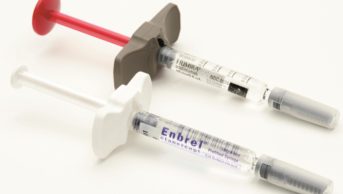
Shutterstock.com
High nitric oxide (NO) levels are involved in the development of diseases including rheumatoid arthritis (RA), through the stimulation of cytokine-induced bone resorption and cell apoptosis.
In a study in Advanced Materials (11 October 2017), researchers explored the development of a polymer hydrogel that rapidly swells in response to NO, but not to other gases, that could potentially be implanted into joints with RA[1]
.
The hydrogel consists of acrylamide and incorporates a novel crosslinker between linear-type polymers that selectively react with NO. The crosslinkers break when exposed to NO, causing the polymer to swell. The team also showed that in this way, the hydrogel was able to release a protein drug that was loaded into its structure.
The researchers said the gel could be used to absorb toxic NO at disease sites, and that they are exploring the polymer as a drug-delivery system in RA.
References
[1] Park J, Pramanick S, Park D et al. Therapeutic-gas-responsive hydrogel. Adv Mater 2017. doi: 10.1002/adma.201702859


